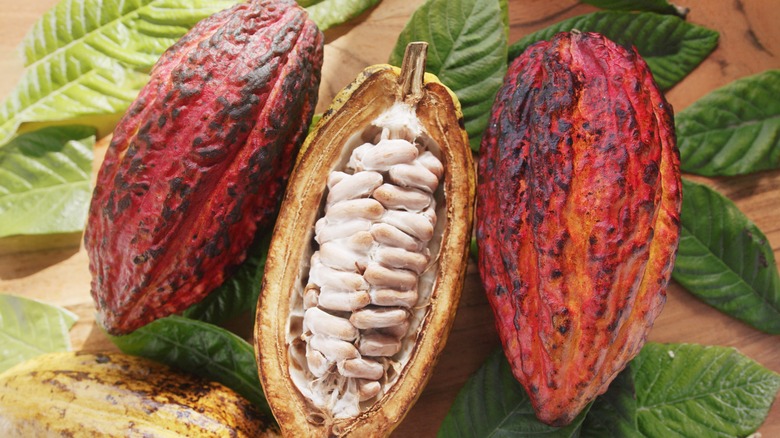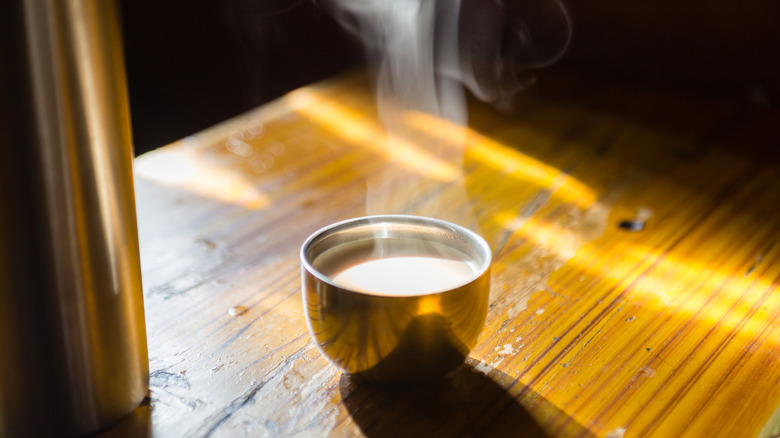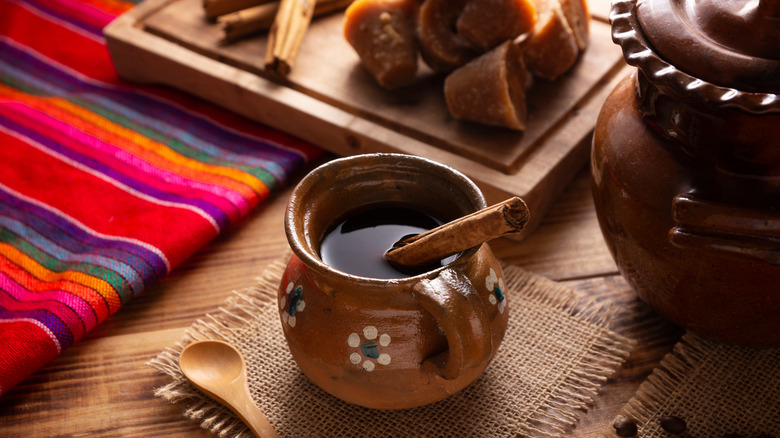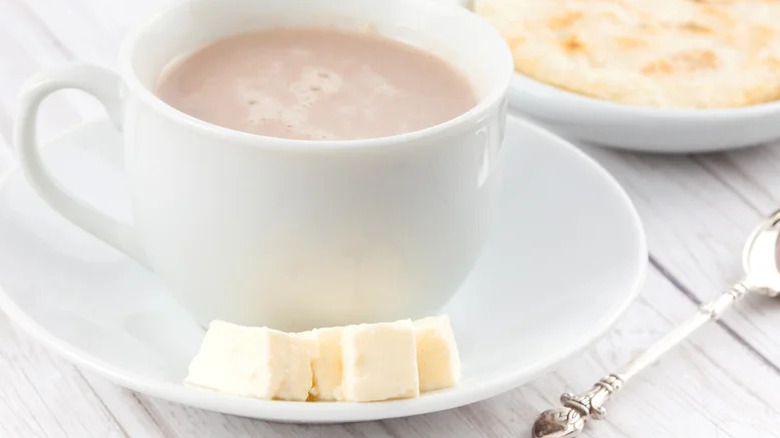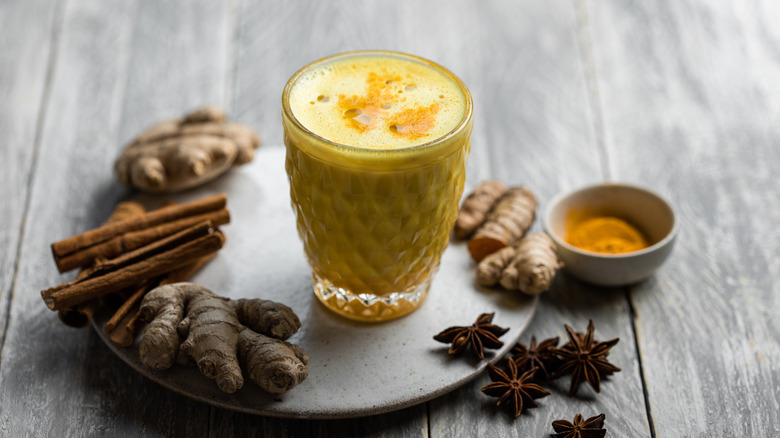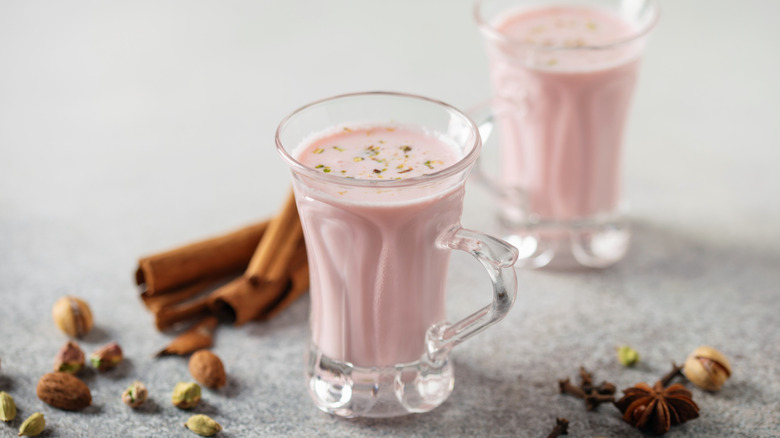15 Unique Hot Drinks From Around The World
As frost crystalizes on our windshields and our jackets get thicker and thicker, daydreams of hot cocoa and steaming early grey dance like sugar plums in our heads. Although nothing is more comforting than a toasty hot beverage on a crisp winter day, these comfort drinks can be enjoyed all year-round. In fact, some of the warmest countries in the world drink tea and other hot beverages throughout the year. And scientifically speaking, they are onto something. Hot drinks promote sweating, which is a cooling mechanism for our bodies. So, whether you are bundled up by the fire or roasting in the sunshine, it's always an appropriate time to grab a hot drink. And why stop at tea and hot cocoa when there are endless unique hot drinks from around the world?
As an anthropology major with a focus in food culture, I've always been driven to expand my culinary abilities by pulling from recipes from around the world. After becoming a recipe designer and plant-based chef, stepping outside of my culinary comfort zone became essential. This means experimenting with both unique ingredients and cuisine. In addition, the importance of pairing a borrowed recipe with a beverage from that culture is important, both in terms of flavor pairing and capturing the full experience. Learning about a recipe's history and cultural significance also enhances the experience, giving you a more complete understanding and appreciation for what you're about to consume. Follow me on this overseas journey as we experiment with new flavors, ingredients, and techniques to make some of the best unique hot drinks from around the world.
1. Hot Toddy
Although you may have heard of a hot toddy before, it still qualifies as a pretty unique hot drink in my book. Besides the fact that most alcoholic drinks are served cold, this one has a rich cross-cultural history and is quite reachable for most folks. In fact, you likely have many of the ingredients in your pantry and refrigerator already. Essentially, a hot toddy is an alcoholic version of what you might make yourself if you have a sore throat: hot water with lemon and honey. The fourth ingredient is what makes it unique. Whiskey, particularly bourbon, is most often used as an alcoholic element, but people tend to experiment with other dark liquors.
Hot toddies were created in India using fermented palm sap in the early 1600s, called a "taddy." From there, the British who occupied India at the time adapted the drink by adding spices and sugars along with hot water almost two centuries later. From there, it became a popular pub staple all over England and can be found, come winter, all around the world. Bring this blended cultural drink to your home by making your own warm and cozy hot toddy recipe.
2. Koko Samoa
After spending nearly half a year in Samoa, I came to crave a hot cup of koko Samoa every time I sat down for an important meal. Although kava is more widely consumed outside of the islands, and more popularly known, koko Samoa is perhaps one of the most specialized drinks. It would be surprising to find it served elsewhere, and it has a long and rich history that dates back well before colonizers set foot on the Island. Koko Samoa is made from cocoa seeds of the Trinitario variety which is rare and quite expensive outside of the Island.
The seeds are dried, ground into a paste, and then mixed with hot water. This creates a savory, rich mouthfeel and flavor that holds deep chocolate notes without the addition of sugar. It reads similar to black coffee but with slightly spicy undertones and less of a toasted flavor. It's perhaps one of my favorite traditional drinking chocolates from around the world because not only is the singular ingredient rare, but its flavors are unmatched. If you're ever in the South Pacific, Samoa is a must-visit location for a truly unique hot drink and rich cultural experience. Alternatively, you can order koko Samoa powder made from Trinitario beans at a relatively steep but worthy price.
3. Api Morado
When we talk about comfort foods, we're often referring to foods that are familiar, rich, and irresistible. Although api morado might not be familiar to you, it is certainly comforting, as it is warm, sweet, and thick. This Altiplano drink is meant for just that, comfort and warmth, as it was developed in the mountains of the Andes which can get brutally cold. Bolivians and Peruvians tend to enjoy this beverage for breakfast, sometimes served with a pastry, but it can be enjoyed all day long. It is made by mixing purple corn flour with hot water, orange rind, cinnamon, cloves and other spices, and pineapple juice for sweetness.
Because of the corn flour, the drink becomes thick. Some describe it as drinking hot corn sugar because of the intense sweetness from the pineapple juice. The drink itself is a warm purple, mimicking the color of beets, and is often a bit frothy after it's been mixed. And although adding flour to a beverage may seem highly unique, it's actually a practice used to thicken hot chocolate around the world.
4. Po Cha
If you've ever dined at a Tibetan restaurant then you've likely seen po cha on the menu. In fact, it's become so well-known that biohackers are taking the prize ingredient, adapting it, and adding it to coffee, calling it bulletproof coffee. That's right, you guessed it, the secret ingredient to po cha tea is fat. And up in the Himalayas they use yak butter to get the job done. When trying to stay warm in a freezing, high-elevation community, fat is essential for both warmth and energy. The more extra calories you have to burn the better, and there is nothing more comforting than melted butter, let's be honest.
Besides yak butter and tea, po cha is made with yak milk and salt. This makes for a savory, fatty, and fragrant combination to start the day. It's an ancient tradition that has lived on through time, still popular to this day. However, not all folks can afford to drink po cha on a daily basis because yak butter and milk are both expensive.
5. Hirezake
Hirezake is so unique, that those who indulge risk their lives to do so. That's right, this drink is delicious, desirable, and deadly. Have you ever heard of fugu, the poisonous pufferfish served in Japan? Well, they don't stop at entrées when it comes to daring cuisine. That same pufferfish is used in making a warm cocktail called hirezake, also known as "fin sake." Unlike most hot drinks, this beverage is rich in umami flavors stemming from the fish fin which is submerged in hot sake.
Although hirezake is an ancient drink, its popularity is spreading all around the world, with a special interest in the United States. Perhaps is the warm savory flavors, or the Russian roulette aspect, but either way the deadly drink has stood the test of time. Luckily, the pufferfish will undergo several examinations to ensure it's not poisonous before it's served. However, even after undergoing specific exams and protocols, drink at your own risk, as the possibility of ingesting poison is always present. Just to be clear, I am not encouraging you to play with fate, just relaying information about a unique and deadly drink.
6. Café de Olla
Sometimes the contributing factor that makes a drink unique is a specially sourced ingredient, other times it's the smokiness of an open flame or the water used in the boiling process. What makes café de olla unique is the pots it's brewed in. This hot Mexican coffee drink is deep in caramel flavors, with ingredients like brown sugar and cinnamon.
As is tradition, clay pots are used for the brewing process, suspected to originally be out of convenience. Have you ever noticed that water just tastes different when drunk from a mug? Or milk isn't the same in a paper cup? Well, many believe that the clay pot alters the flavor of the café de olla, making it extra irresistible. The dark brown sugar is the second most important ingredient behind the clay-pot-brewed coffee. The rich molasses-like flavor gives toffee and vanilla undertones which enhance both the scent and flavor. Although you may not have a clay pot for brewing, you may be able to grasp the essence of café de olla using brown sugar and cinnamon in your next cup of joe.
7. Mulled wine
Many traditional drinks have been around since ancient times. Perhaps today we enjoy them with a few new ingredients, and we know for sure that the quality of our produce has shifted over time. However, the basic recipes have been beloved for centuries and mulled wine is no exception. Mulled wine has been consumed by Romans since the 2nd century. Its purpose ranged from a warming mechanism to a defense against disease. Since then, it's spread across Europe with each nation adapting its name and ingredients.
At its core, mulled wine is warm spiced wine. Throughout time other botanicals were added, and sometimes sweeteners. Its popularity increases around the holidays, especially because its species reminds us of the festivities and celebratory recipes. Brew up a cup of classic cozy mulled wine, and follow some tips for serving the mulled wine drink. Mulling spices typically include cinnamon, cloves, star anise, peppercorn, allspice, nutmeg, and cardamom, and you can often find them pre-mixed.
8. Chocolate Santafereño
We all know that cheese and chocolate are a heavenly combination, ask any charcuterie board, but have you ever tried cheese in your hot chocolate? Likely, unless you're from Colombia, the answer is "no." In fact, Chocolate santafereño as it's called, is quite popular in the country. South America is known for its deep historical roots in the tradition of drinking chocolate, so it's no surprise that the hot chocolate in that neck of the woods is difficult to rival.
Chocolate santafereño is made with just four ingredients: hot water or milk, chocolate, sugar, and a soft piece of cheese. However, different regions like to incorporate a variety of spices. It's best prepared with a molinillo, similar to a Japanese chasen, which ensures the mixture of liquid, chocolate, and sugar is whisked and smooth. This hot mixture is then poured into a cup containing a piece of soft and creamy cheese. This Colombian cheese hot chocolate contains the dynamic duo you didn't know you needed.
9. Badam Doodh
You may have never heard of badam doodh, but do the terms "golden milk" or "turmeric latte" ring a bell? Badam doodh is a turmeric and hot milk drink filled with Indian spices that warms the soul. The drink has been popularized across the West, as it holds incredible health benefits and is a caffeine-free alternative to coffee and tea. This Ayurvedic drink is a perfect round-the-clock beverage that is loaded to the brim with superfoods. Luckily, a turmeric golden milk haldi doodh recipe isn't difficult to make at home.
To make Indian haldi doodh turmeric milk start with your base of whole milk. Hindus abstain from beef, but often indulge in milk. However, you can use any kind of milk or milk-alternative ranging from cashew cream to coconut milk. Over medium heat, add the milk, coconut oil, and spices and keep the mixture moving. Save the honey and black pepper until the end. Black pepper helps to activate the turmeric's active ingredient, curcumin, which has anti-inflammatory benefits.
10. Kuna
The Kuna Indians of Panama are onto something: Obtain peak health by drinking hot chocolate. Twist my arm! However, the recipe varies from our own laden with dairy and sugar, and instead contains lots of antioxidants and fiber. Although you might think you drink a lot of cocoa, Kuna Indians drink around 40 cups per week, making their risk for cardiovascular events minuscule and reducing inflammation in the body.
To make this thick, savory, and rich drink you only need two ingredients: cocoa beans and bananas. The bananas are boiled in water and mixed before ground cocoa beans are added. The mixture is then strained and enjoyed hot. It is thick, frothy, slightly bitter, and has a beautiful undertone of sweetness delivered by the bananas. This sweet tradition of drinking chocolate could just be the thing your ticker needs to stay strong, and your taste buds will thank you, too.
11. Kashmiri Chai
Many of these unique hot drinks from around the world are dark, robust, and earthy. Kashmiri chai is perhaps one of the more objectively beautiful, delicate, and unique hot drinks when it comes to appearance. That's because this beverage, also known as Noon chai, is pink!
It's widely believed that the Persians brought the traditions of Noon chai to Kashmir during their rule and it developed from there: a creation come to life when two cultures blended under unfortunate circumstances. The process of making the tea requires patience, as it goes through several steps involving boiling and waiting. In fact, the tea leaves need to be soaked before being boiled to help release their strong pink hues. Ingredients like nuts, baking soda, salt, and spices help to bring the creation to life. The colorful and warming drink symbolizes hospitality and is often presented to guests in Kashmir upon arrival. There's nothing like a warm cup of Noon chai to welcome you home.
12. Yerba Maté
Although most drinks are consumed for their flavor, yerba maté is mostly popular for its anti-jitter caffeine effect and health benefits. It has a grassy and sometimes bitter flavor but can be mixed with sweeteners like honey, and citrus like lemon to help balance the flavor. The evergreen trees that produce the leaves for yerba maté are grown in South America, but today you can find the tea served all over the world. Maté is the national drink of Argentina but you can find it canned in almost any grocery store across the Americas. The history of yerba maté is fascinating, as it has become a staple drink in many cultures.
Although it's beloved for its caffeine, in some cultures and throughout time it is believed to have purifying properties. Yerba maté has been used in rituals, ceremonies, and many cultural practices. It's also been used for trade, helping to bring nations and cultures together for centuries.
13. Emoliente
Emoliente is referred to as a tea but is, in fact, a mix of herbs, spices, and other natural ingredients. The recipe itself varies depending on the person making it, but there are a few staple ingredients that really make emoliente. These ingredients include flaxseed, barley, and lemon. Other ingredients include dried horsetail, lemongrass, and honey to sweeten. This powerhouse drink can be used for medical purposes, helps with digestion, and is not too rough on the taste buds. Perhaps this is why it can be found all over Peru being sold by vendors on the streets.
If you're ever in that neck of the woods, it's a drink you must try if traveling to Peru. For some of us, the closest we will get to a vacation this year is enjoying our tropical screensaver. If that's the case, you can order emoliente mix online or find it in specialty stores. Just keep in mind that each package might taste slightly different, as the recipe is in the hands of the creator.
14. Atole
This Mexican beverage is more like a drinkable porridge. Like many hot drinks from around the world, Atole has base ingredients, but can vary greatly depending on the creator. In its most basic form, this is a maize-based drink that incorporates sugar and spices. Other flours like oatmeal flour, rice flour, and barley flour can stand in maize's place, and the thickness of the drink tends to vary.
Peanut atole is my favorite version of the drink. It's made with milk and peanut butter along with the classic ingredients. Chocolate atole the Oaxacan drink that uses a rare type of cocoa is a favorite amongst chocolate lovers. Other ingredients include vanilla and cinnamon, popular flavorings for hot drinks in South America. The drink is made by toasting the maize and then adding other dry ingredients to the pan. Then, liquid is added and the mixture begins to thicken as the flour absorbs the moisture. The drink is described as foamy, thick, comforting, sweet, and hearty, especially when made with nuts or nut butter.
15. Besan Doodh
If you're looking for a hearty energy drink that's loaded with protein and fat, then look no further than besan doodh. In Northern India and Pakistan, this thick and toasty drink is popular for both medicinal purposes and culinary enjoyment. Besan doodh is said to cure anything from sore throats to colds, and is indeed quite comforting.
It's made using a few steps. First, melt the ghee and toast the nuts. Then toast the chickpea flour, which is becoming more and more popular in the West. If you've ever worked with chickpea flour then you know it's extremely bitter if not cooked thoroughly. Next, add the milk and whisk it until smooth. The spices like cardamom and saffron are added next. Re-introduce the fried nuts and drizzle the drink with honey. Enjoy it hot. While making this drink, I like to use coconut oil instead of ghee, but it's all about personal preference.


